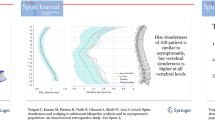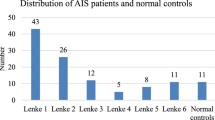Abstract
Purpose
To evaluate associations between vertebrae and disc shape asymmetry and adolescent idiopathic scoliosis (AIS) curve severity.
Methods
Analysis included normal screening referrals and patients with right, main thoracic AIS who underwent upright, biplanar radiographs with 3D reconstruction at a single institution from 2010 to 2015. Peri-apical anterior, posterior, right, and left vertebral body heights (aVBH, pVBH, rVBH, lVBH) and intervertebral disc heights (DH) were measured, and ratios of these measurements were calculated in sagittal and coronal planes. Correlations were performed between curve severity and height measurements. Sagittal and coronal plane components of these measurements were compared between normal controls with coronal curve measurements < 11° and patients with moderate (11°–49°) and severe curves (≥ 50°), with tolerance intervals established for the normal controls.
Results
The analysis included a total of 397 patients. Patients with AIS had coronal curve measurements ranging from 11° to 101°. Greater coronal curve severity strongly correlated with smaller pVBH relative to aVBH and moderately correlated with smaller pDH relative to aDH (r = − 0.643, r = − 0.305, respectively). aVBH was greater for larger curves; pVBH remained stable. Scoliosis severity strongly correlated with right relative to left VBH and DH ratios (r = 0.919, r = 0.865 respectively). In comparison of normal controls to severe curves, severe curves had significantly greater aVBH and aDH, while pVBH was not significantly different and pDH was significantly less. Nearly half (46.9%) of the severe curves were below the range of normal for PA vertebral height ratio.
Conclusion
In right, main thoracic AIS, greater main thoracic curve severity is associated with greater sagittal and coronal plane asymmetry of both the vertebral bodies and the discs. Severity more strongly correlates with vertebral changes in symmetry than with disc changes, though both are present.
Similar content being viewed by others
References
Dickson RA (1983) Scoliosis in the community. Br Med J (Clin Res Ed) 286:615–618
Rogala EJ, Drummond DS, Gurr J (1978) Scoliosis: incidence and natural history. A prospective epidemiological study. J Bone JtSurg Am 60:173–176
Stirling AJ, Howel D, Millner PA et al (1996) Late-onset idiopathic scoliosis in children six to fourteen years old. A cross-sectional prevalence study. J Bone Joint Surg Am 78:1330–1336
Weinstein SL (1999) Natural history. Spine (Phila Pa 1976) 24:2592–2600
Fairbank J (2004) Historical perspective: William Adams, the forward bending test, and the spine of Gideon Algernon Mantell. Spine (Phila Pa 1976) 29:1953–1955
de Peloux J, Fauchet R, Stagnara P (1965) Le plan d’election pour l’examenradiologique des cyphoscoliosis. Rev ChirurgOrthop 51:517–524
Deacon P, Flood BM, Dickson RA (1984) Idiopathic scoliosis in three dimensions. A radiographic and morphometric analysis. J Bone JtSurg Br 66:509–512
Lenke LG, Betz RR, Harms J et al (2001) Adolescent idiopathic scoliosis: a new classification to determine extent of spinal arthrodesis. J Bone JtSurg Am 83:1169–1181
Brink RC, Schlosser TPC, Colo D et al (2017) Anterior spinal overgrowth is the result of the scoliotic mechanism and is located in the disc. Spine (Phila Pa 1976) 42:818–822
Brink RC, Schlosser TPC, van Stralen M et al (2018) Anterior-posterior length discrepancy of the spinal column in adolescent idiopathic scoliosis-a 3D CT study. Spine J 18:2259–2265
Guo X, Chau WW, Chan YL et al (2003) Relative anterior spinal overgrowth in adolescent idiopathic scoliosis. Results of disproportionate endochondral-membranous bone growth. J Bone JtSurg Br 85:1026–1031
Newell N, Grant CA, Keenan BE et al (2016) Quantifying progressive anterior overgrowth in the thoracic vertebrae of adolescent idiopathic scoliosis patients: a sequential magnetic resonance imaging study. Spine (Phila Pa 1976) 41:E382–E387
Porter RW (2000) Idiopathic scoliosis: the relation between the vertebral canal and the vertebral bodies. Spine (Phila Pa 1976) 25:1360–1366
Schlosser TP, van Stralen M, Brink RC et al (2014) Three-dimensional characterization of torsion and asymmetry of the intervertebral discs versus vertebral bodies in adolescent idiopathic scoliosis. Spine (Phila Pa 1976) 39:E1159–E1166
Schlosser TP, van Stralen M, Chu WC et al (2016) Anterior overgrowth in primary curves, compensatory curves and junctional segments in adolescent idiopathic scoliosis. PLoS ONE 11:e0160267
Wever DJ, Veldhuizen AG, Klein JP et al (1999) A biomechanical analysis of the vertebral and rib deformities in structural scoliosis. Eur Spine J 8:252–260
Parent S, Labelle H, Skalli W et al (2004) Vertebral wedging characteristic changes in scoliotic spines. Spine (Phila Pa 1976) 29:E455–E462
Xiong B, Sevastik J, Hedlund R et al (1994) Sagittal configuration of the spine and growth of the posterior elements in early scoliosis. J Orthop Res 12:113–118
Glaser DA, Doan J, Newton PO (2012) Comparison of 3-dimensional spinal reconstruction accuracy: biplanar radiographs with EOS versus computed tomography. Spine (Phila Pa 1976) 37:1391–1397
Newton PO, Fujimori T, Doan J et al (2015) Defining the “Three-Dimensional Sagittal Plane” in thoracic adolescent idiopathic scoliosis. J Bone JtSurg Am 97:1694–1701
Stokes IA (1994) Three-dimensional terminology of spinal deformity. A report presented to the Scoliosis Research Society by the Scoliosis Research Society Working Group on 3-D terminology of spinal deformity. Spine (Phila Pa) 19:236–248
Grivas TB, Dangas S, Samelis P et al (2002) Lateral spinal profile in school-screening referrals with and without late onset idiopathic scoliosis 10°–20°. Stud Health Technol Inform 91:25–31
Grivas TB, Vasiliadis E, Malakasis M et al (2006) Intervertebral disc biomechanics in the pathogenesis of idiopathic scoliosis. Stud Health Technol Inform 123:80–83
Will RE, Stokes IA, Qiu X et al (2009) Cobb angle progression in adolescent scoliosis begins at the intervertebral disc. Spine (Phila Pa 1976) 34:2782–2786
Patel A, Schwab F, Lafage V et al (2010) Computed tomographic validation of the porcine model for thoracic scoliosis. Spine (Phila Pa 1976) 35:18–25
Somerville EW (1952) Rotational lordosis; the development of single curve. J Bone JtSurg Br 34-B:421–427
Funding
This work was funded in part by the Rady Children’s Spine Center Research Fund and in part by research grants to Setting Scoliosis Straight Foundation from DePuy Synthes Spine, EOS imaging, K2M, Medtronic, NuVasive and Zimmer Biomet in support of Harms Study Group research.
Author information
Authors and Affiliations
Contributions
Conception or design of the work; or acquisition, analysis, or interpretation of data for the work: TBS, TPB, CEB, FR, MJ, PON. Drafting or critically revising the work: TBS, TPB, CEB, FR, MJ, PON. Final approval of the version to be published: TBS, TPB, CEB, FR, MJ, PON.
Corresponding author
Ethics declarations
Conflict of interest
One or more of the authors reports funding to their institution related to the submitted work and financial relationships with entities outside of the submitted work. Details of which can be found in the individual author disclosure forms submitted with this manuscript.
Ethical approval
IRB approval was obtained for this study.
Additional information
Publisher's Note
Springer Nature remains neutral with regard to jurisdictional claims in published maps and institutional affiliations
Rights and permissions
About this article
Cite this article
Sullivan, T.B., Bastrom, T.P., Reighard, F. et al. Changes in peri-apical vertebral body and intervertebral disc shape in both the sagittal and coronal planes correlate with scoliosis severity: a 3D study of 397 patients. Spine Deform 9, 959–967 (2021). https://doi.org/10.1007/s43390-021-00293-8
Received:
Accepted:
Published:
Issue Date:
DOI: https://doi.org/10.1007/s43390-021-00293-8




